As Americans continue to give the news media a solid grade overall for coverage of the COVID-19 pandemic, the percentage who say journalists have exaggerated the risks of the outbreak has decreased notably in recent weeks, according to survey data from Pew Research Center’s Election News Pathway project.
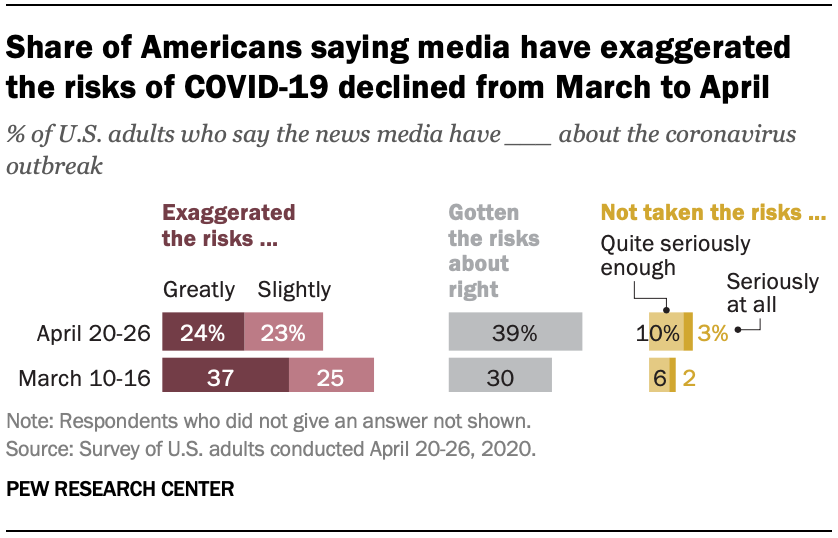 Among U.S. adults surveyed from April 20-26, 69% say the news media have covered the outbreak very well or somewhat well, a number that is virtually unchanged from the 70% of respondents who said the same thing in a survey conducted from March 10-16.
Among U.S. adults surveyed from April 20-26, 69% say the news media have covered the outbreak very well or somewhat well, a number that is virtually unchanged from the 70% of respondents who said the same thing in a survey conducted from March 10-16.
But as the toll from the coronavirus has grown dramatically over time, there has been movement in the share of Americans who say the news media have greatly or slightly exaggerated the risks it poses – with that percentage dropping from 62% in March to 48% in April. That includes a decline in the portion saying the media have greatly exaggerated the risks, from 37% to 24%. At the same time, the portion of respondents who say the media have gotten the COVID-19 risks about right grew by 9 percentage points – from 30% to 39%.
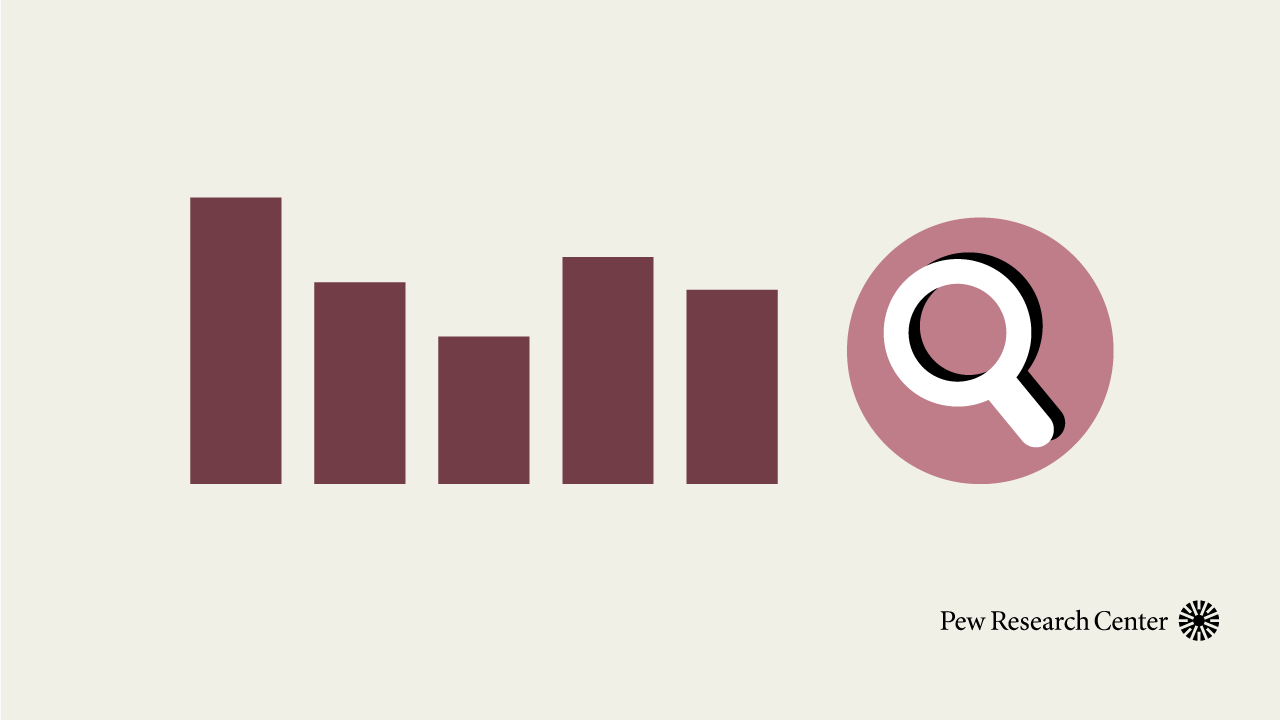
Want to see more data on these questions?
To analyze these survey questions by additional media habits and demographic characteristics, visit the interactive tool and access the dataset.
Underlying these overall numbers are deep partisan divisions about the media’s coronavirus coverage – divisions that were evident in March and remain so in April. Most recently, more than half of Republicans and independents who lean toward the Republican Party (54%) say the media have covered COVID-19 somewhat or very well in the April survey, a number that swells to about eight-in-ten among Democrats and Democratic-leaning independents (82%).
And, while about two-thirds of Republicans and Republican leaners (68%) in the April survey say the media slightly or greatly exaggerated COVID-19 risks, that is true of only three-in-ten Democrats and Democratic leaners.
The portion of those saying the media exaggerated the risks declined across both parties from March to April. But that decrease was considerably more pronounced for Democrats than Republicans – by a ratio of two-to-one.
Public overall says media have done well covering the crisis, but differences by party and ideology are pronounced
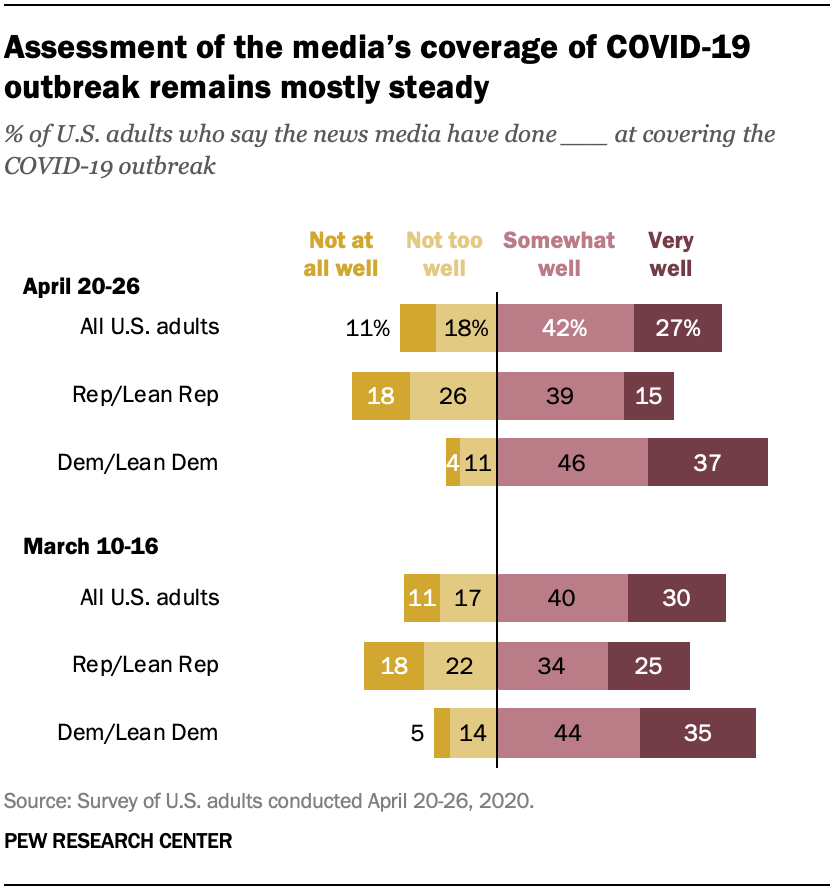 Americans’ generally positive view of the media’s coverage of the coronavirus outbreak has remained steady in recent weeks. In March, 70% of all adults said news organizations have done very well or somewhat well in that task, with nearly the exact same portion, 69%, saying this now. Within that total, there was also little change from March (30%) to April (27%) in the percentage who say the media have done very well.
Americans’ generally positive view of the media’s coverage of the coronavirus outbreak has remained steady in recent weeks. In March, 70% of all adults said news organizations have done very well or somewhat well in that task, with nearly the exact same portion, 69%, saying this now. Within that total, there was also little change from March (30%) to April (27%) in the percentage who say the media have done very well.
What also remained consistent across both time periods is the significant partisan divergence on that question. As of late April, 54% of Republicans and Republican-leaning independents say the media have performed somewhat or very well, compared with a full 82% of Democrats and Democratic leaners – a gap of 28 percentage points, modestly larger than the 21-point gap in the earlier survey. (The portion of Republicans saying the media have done very well actually declined 10 points.) It is worth noting that the strong partisan divide exists alongside a consistent element of President Donald Trump’s frequent briefings on COVID-19: direct criticism of news organizations and journalists.
That partisan gap is even larger among ideological segments within each party. As of April, about half of conservative Republicans (48%) say the media have done very or somewhat well in covering COVID-19. That number grows to 62% among moderate and liberal Republicans, and it increases further to 81% among conservative and moderate Democrats and 84% among liberal Democrats.
Americans, particularly Democrats, now less inclined to think the news media have exaggerated the risks of COVID-19
In the period covered by the two surveys, the toll taken by the virus and the reaction to it changed dramatically. Public schools and nonessential businesses were shut down while America’s governors issued stay-at-home orders to residents in most states. On March 10, there were fewer than 1,500 reported cases in the U.S. By April 26, the nation was closing in on 1 million cases.
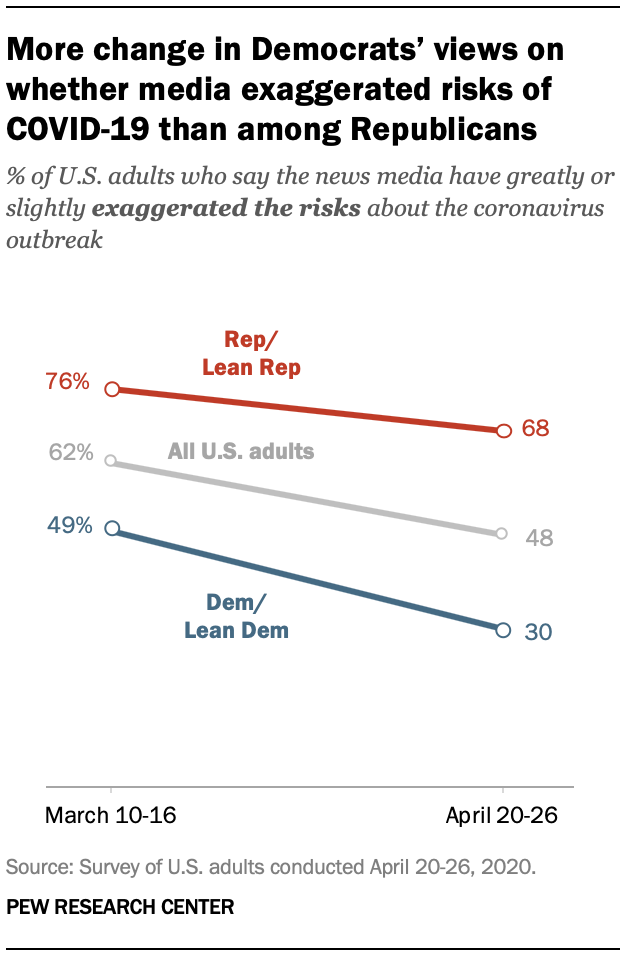 In the March survey, about six-in-ten Americans (62%) said that the media had exaggerated, either slightly or by a great deal, the risks of COVID-19. An additional 30% said they had gotten the risks about right, and 8% said they had not taken the risks seriously enough or not taken them seriously at all. In the April survey, about half (48%) of adults say the media have exaggerated the risks slightly or greatly, 39% say they have gotten it about right and 13% say they have not taken it seriously enough.
In the March survey, about six-in-ten Americans (62%) said that the media had exaggerated, either slightly or by a great deal, the risks of COVID-19. An additional 30% said they had gotten the risks about right, and 8% said they had not taken the risks seriously enough or not taken them seriously at all. In the April survey, about half (48%) of adults say the media have exaggerated the risks slightly or greatly, 39% say they have gotten it about right and 13% say they have not taken it seriously enough.
The partisan chasm on this question grew even larger from March to April. The percentage of both Republicans and Democrats saying the media have exaggerated the risks dropped, with the biggest decrease coming among Democrats.
Back in March, 76% of Republicans and Republican-leaning independents said the media had exaggerated COVID-19 risks compared with 49% of Democrats and Democratic leaners, a difference of 27 percentage points.
As of April, about two-thirds of Republicans (68%) say the media have exaggerated the risks. Fewer than half as many Democrats surveyed in April (30%) say the same, meaning the gap between Republicans and Democrats grew to 38 points.
At the same time, the percentage of Democrats who say the media have gotten the risks about right climbed from 41% in March to 55% in the April survey. Among Republicans, it moved up modestly from 17% to 20%.
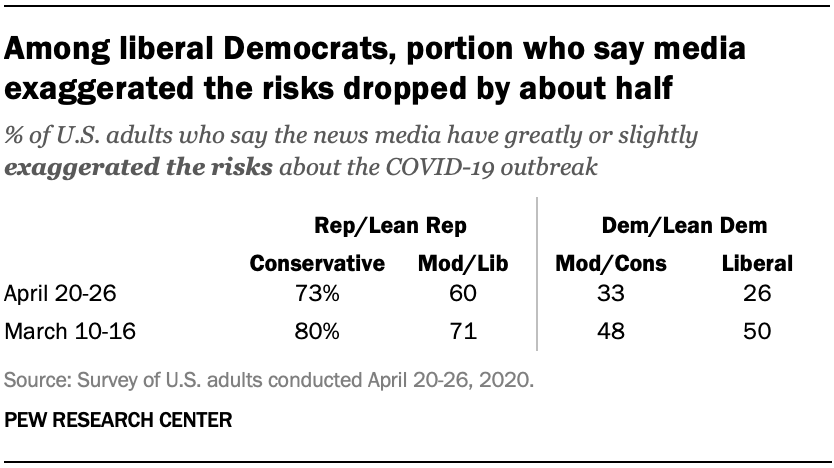 Adding ideology onto political party identification shows particularly wide gaps between conservative Republicans and liberal Democrats. Almost three-quarters of conservative Republicans (73%) respond that the media have exaggerated the COVID-19 risks, compared with 60% of moderate to liberal Republicans. One-third of moderate and conservative Democrats also say journalists have exaggerated the risks, a number that is even lower, 26%, among liberal Democrats. Only 16% of conservative Republicans say the media have gotten the risks about right, compared with 57% of liberal Democrats.
Adding ideology onto political party identification shows particularly wide gaps between conservative Republicans and liberal Democrats. Almost three-quarters of conservative Republicans (73%) respond that the media have exaggerated the COVID-19 risks, compared with 60% of moderate to liberal Republicans. One-third of moderate and conservative Democrats also say journalists have exaggerated the risks, a number that is even lower, 26%, among liberal Democrats. Only 16% of conservative Republicans say the media have gotten the risks about right, compared with 57% of liberal Democrats.
As was the case with parties overall, the shares of conservative Republicans and liberal Democrats who say the media have exaggerated the risks decreased since March, but the drop was steeper among liberal Democrats. The percentage of conservative Republicans saying the media exaggerated risks fell from 80% in the March survey to 73% in April. But the percentage of liberal Democrats who gave that same response was cut nearly in half – from 50% to 26%.
The percentage of conservative Republicans who said the media have gotten the risks about right stayed about equal (14% in March and 16% in April). For liberal Democrats, that figure jumped from 39% to 57%.
These measures and more can be explored further in the Election News Pathways data tool, where all of the data associated with this project is available for public use. (To see results for both time frames reported in this analysis, click on the survey dates in the bottom footnote.) You can read more about our research on public opinion of COVID-19 here.
Data from this analysis comes from a survey conducted March 10-16, 2020, and a survey conducted April 20-26, 2020. For the March 10-16 survey, see the survey questions and methodology, or access the dataset. For the April 20-26 survey, see the survey questions and methodology, or access to the dataset.
Acknowledgments: The Election News Pathways project was made possible by The Pew Charitable Trusts. Pew Research Center is a subsidiary of The Pew Charitable Trusts, its primary funder. This initiative is a collaborative effort based on the input and analysis of a number of individuals and experts at Pew Research Center.


